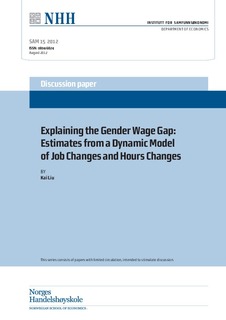| dc.contributor.author | Liu, Kai | |
| dc.date.accessioned | 2013-03-13T09:33:57Z | |
| dc.date.available | 2013-03-13T09:33:57Z | |
| dc.date.issued | 2012-08 | |
| dc.identifier.issn | 0804-6824 | |
| dc.identifier.uri | http://hdl.handle.net/11250/163436 | |
| dc.description.abstract | I address the causes of the gender wage gap with a new dynamic model of wage, hours, and job
changes that permits me to decompose the gap into a portion due to gender differences in preferences
for part-time work and in constraints. The dynamic model allows the differences in constraints to
reflect possible gender differences in job arrival rates, job destruction rates, the mean and variance of
the wage offer distribution, and the full-time/part-time wage premium. I find that the differences in preferences explain no more than 5% of the gender gap in hourly wages and 7-20% of the gender gap in weekly wages. The differences in constraints, mainly in the form of differences in the mean offered
wages, explain the remaining gender wage gap. Most of the gender differences in employment, hours of work and job turnover can be attributed to the differences in preferences. | no_NO |
| dc.language.iso | eng | no_NO |
| dc.publisher | Norwegian School of Economics, Department of Economics | no_NO |
| dc.relation.ispartofseries | Discussion paper;15/2012 | |
| dc.title | Explaining the gender wage gap : estimates from a dynamic model of job changes and hours changes | no_NO |
| dc.type | Working paper | no_NO |
| dc.subject.nsi | VDP::Social science: 200::Economics: 210::Economics: 212 | no_NO |
